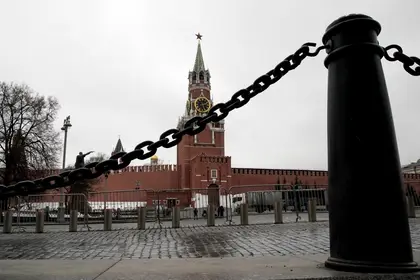Vladimir Putin’s campaign to demolish Ukraine’s power grid and bomb Ukrainians into submission is threatening a critical hydroelectric station on the Dnipro River, which could flood thousands out of their homes and demolish a key piece of the country’s infrastructure.
Russian Federation (RF) forces captured the six-turbine Kakhovka Dam, connecting the towns Beryslav and Nova Kakhovka, on Feb. 24. Advancing Armed Forces of Ukraine (AFU) units began long-range strikes on Russian units and bases in the vicinity in August. The attacks, usually with U.S.-delivered HIMARS precision-guided rockets intensified in September.
Ukrainian President Volodymyr Zelensky, in an Oct. 20 speech to European Union leadership, singled out the power station as under threat of Russian demolition, and accused the Kremlin of planning to blow it up as a terror tactic.
“We have information that Russian terrorists mined the dam and aggregates of the Kakhovka hydroelectric power plant,” Zelensky said. “The dam of this hydroelectric power plant holds about 18 million cubic meters of water. If Russian terrorists blow up this dam, more than 80 settlements, including Kherson, will be in the zone of rapid flooding. Hundreds of thousands of people may be affected.”
Catastrophic destruction of the dam would, theoretically, trigger a flood wave reaching 4.8 meters in height flowing in a five kilometer-wide swell at speeds reaching 24 kph. Flooding would reach Kherson in two hours, achieve high water in 14 hours, and fall back to normal levels in 72 hours, estimated the Telegram information site Zastavnyii, in a widely-reposted graphic.

Kyiv Hit by Massive Drone Attack as Russian Strikes Target Multiple Ukrainian Cities
Mykhailo Podolyak, a Presidential adviser, echoed Zelensky’s claim in a Twitter post, saying Colonel General Sergei Surovikin, commander of all Russian forces in Ukraine, has ordered both the dam and power generators rigged for destruction to delay any Armed Forces of Ukraine (AFU) attack in the southern sector, and to use as a pretext for the forced migration of civilians loyal to Kyiv.
“Russia is preparing a man-made (natural) catastrophe,” Podolyak said.
The Washington-based Institute for the Study of War (ISW) in a Thursday situation estimate said a major break of the dam would help cover RF forces retreating from the right to the left bank of the Dnipro. Potentially, the Kremlin might deploy Russian army blast teams masquerading as Ukrainian saboteurs, to shift the blame for the massive flooding and power grid degradation were the station to be destroyed.
“The Kremlin may try to use such an attack ‘under a foreign flag’ to overshadow the news of the third humiliating retreat of Russian troops, this time from the western part of Kherson,” the ISW report said.
Local resident Telegram channels on Wednesday and Thursday reported RF troop units visibly packing up and driving away from both Beryslav and Nova Kakhovka. At the same time, official Russian sources led by spokesmen from the Kherson occupation administration confirmed a major evacuation of 50,000 to 60,000 civilians from the Kherson region is in progress, as a preliminary step to a major defensive battle General Surovikin and the Russian military are planning to fight in the city.
AFU leadership has clamped down a near-total news blackout from front-line sectors. According to open source media, the closest AFU ground troops to the Kakhovka station are some 35 to 40 kilometers away.
RF occupation administration officials, responding to Zelensky and Podolyak’s claims, argued Kyiv was engaged in a media spin operation of its own, accusing Russian forces of planning an attack on local infrastructure that the AFU is already carrying out itself.
“What’s the point of Russia destroying hydroelectric power stations now?” said Vladimir Leontiev, head of the Nova Kakhovka district, in an interview carried on RF state-controlled media. “Ukraine has been shelling the region every day for the last five months … and not with ten missiles, but with a significantly larger number. This is beneficial only to Ukraine, because it will destroy the dam, the hydroelectric power station, it will disrupt logistics, sow fear and panic, and it will stop the possibility of supplying water through the North Crimean Canal to the territory of Crimea.”
Aside from the hydroelectric plant, Nova Kakhovka has been a key Russian war objective because the North Crimean Canal, terminating near the city, connects the Dnipro River to the water-poor Crimean Peninsula. Russia annexed the Ukrainian territory in 2014 in a bogus referendum. Without the canal, critical RF military bases in Crimea as well as the civilian population have almost no sources of fresh water.
Leontiev claimed, without providing evidence, that the AFU was preparing water-borne mines to float downstream on the Dnipro in order to blow up the dam. The 30-meter tall reinforced concrete dam has been hit repeatedly by AFU rocket strikes with, thus far, seemingly little effect on the structure’s integrity. AFU spokesmen have repeatedly stated that Ukrainian strikes intend to leave local infrastructure intact, if possible, but that RF military targets will be attacked.
The most recent AFU strike near the station, taking place on Oct. 20, according to RF information platforms, hit the dam itself, reducing power generation capacity. Local residents in the chat group Zaradniki Khersonshchini said, in fact, that an RF ammunition dump next to the dam was blown up in a HIMARS attack, in spite of RF army anti-aircraft unit attempts to shoot down incoming rockets. Other posts showed photographs of black billowing smoke typical of an ammunition explosion.
Vladimir Saldo, head of the RF-run Kherson regional administration, in a Thursday public statement said local officials are preparing for a major flood event and persons forced out of their homes by high water would have access to temporary housing and state-provided food. Even if the dam is blown up, and Dnipro River lowlands are flooded, RF forces will stand and fight in Kherson, he said.
You can also highlight the text and press Ctrl + Enter






